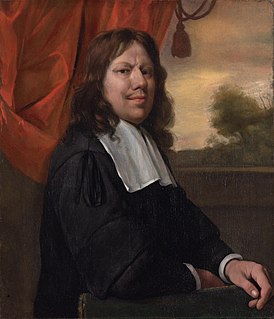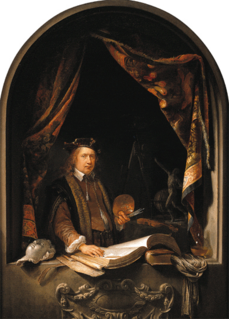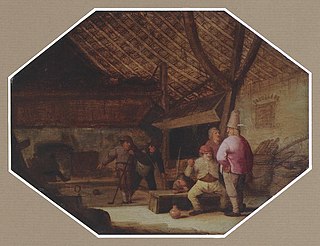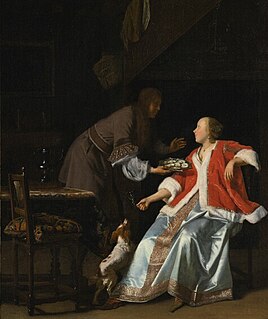
Jan Havickszoon Steen was a Dutch Golden Age painter, one of the leading genre painters of the 17th century. His works are known for their psychological insight, sense of humour and abundance of colour.

Gerrit Dou, also known as GerardDouw or Dow, was a Dutch Golden Age painter, whose small, highly polished paintings are typical of the Leiden fijnschilders. He specialised in genre scenes and is noted for his trompe-l'œil "niche" paintings and candlelit night-scenes with strong chiaroscuro. He was a student of Rembrandt.

Willem van Mieris was an 18th-century painter from the Northern Netherlands.

Utrecht Caravaggism refers to the work of a group of artists who were from, or had studied in, the Dutch city of Utrecht, and during their stay in Rome during the early seventeenth century had become distinctly influenced by the art of Caravaggio. Upon their return to the Dutch Republic, they worked in a so-called Caravaggist style, which in turn influenced an earlier generation of local artists as well as artists in Flanders. The key figures in the movement were Hendrick ter Brugghen, Gerrit van Honthorst and Dirck van Baburen, who introduced Caravaggism into Utrecht painting around 1620. After 1630 the artists moved in other directions and the movement petered out. The Utrecht Caravaggisti painted predominantly history scenes and genre scenes executed in a realist style.

Judith Jans Leyster was a Dutch Golden Age painter. She painted genre works, portraits and still lifes. Although her work was highly regarded by her contemporaries, Leyster and her work became almost forgotten after her death. Her entire oeuvre was attributed to Frans Hals or to her husband, Jan Miense Molenaer, until 1893. It wasn't until the late 19th century that she was recognized for her artistic abilities.

Municipal Museum Boijmans Van Beuningen is an art museum in Rotterdam in the Netherlands. The name of the museum is derived from the two most important collectors of Frans Jacob Otto Boijmans and Daniël George van Beuningen. It is located at the Museumpark in the district Rotterdam Centrum, close to the Kunsthal and the Natural History Museum.

Dutch Golden Age painting is the painting of the Dutch Golden Age, a period in Dutch history roughly spanning the 17th century, during and after the later part of the Eighty Years' War (1568–1648) for Dutch independence.

Hans Bol or Jan Bol, was a Flemish painter, print artist, miniaturist painter and draftsman. He is known for his landscapes, allegorical and biblical scenes, and genre paintings executed in a late Northern Mannerist style.

Michelangelo Cerquozzi, known as Michelangelo delle Battaglie was an Italian Baroque painter known for his genre scenes, battle pictures, small religious and mythological works and still lifes. His genre scenes were influenced by the work of the Flemish and Dutch genre artists referred to as the Bamboccianti active in Rome who created small cabinet paintings and prints of the everyday life of the lower classes in Rome and its countryside. One of the leading battle painters active in Italy in the first half of the 17th century, Michelangelo Cerquozzi earned the nickname 'Michelangelo delle Battaglie'.

Jan Miel was a Flemish painter and engraver who was active in Italy. He initially formed part of the circle of Dutch and Flemish genre painters in Rome who are referred to as the 'Bamboccianti' and were known for their scenes depicting the lower classes in Rome. He later developed away from the Bamboccianti style and painted history subjects in a classicising style.

Jan Miense Molenaer, was a Dutch Golden Age genre painter whose style was a precursor to Jan Steen's work during Dutch Golden Age painting. He shared a studio with his wife, Judith Leyster, also a genre painter, as well as a portraitist and painter of still-life. Both Molenaer and Leyster may have been pupils of Frans Hals.

The Fijnschilders, also called the Leiden Fijnschilders, were Dutch Golden Age painters who, from about 1630 to 1710, strove to create as natural a reproduction of reality as possible in their meticulously executed, often small-scale works.

Balthasar van den Bossche (1681–1715) was a Flemish painter who is mainly known for his wide range of genre subjects and occasional portraits.

Jan Frans van Dael or Jean-François van Dael was a Flemish painter and lithographer specializing in still lifes of flowers and fruit. He had a successful career in Paris where his patrons included the Empresses of Empire France as well as the kings of Restoration France. His work stands in the Flemish and Dutch tradition of flower painting with a sober composition and attention to detail to which he added a French-inspired decorative monumentality.

Bartholomeus Molenaer was a Dutch Golden Age genre painter.

Battle Between Carnival and Lent is an oil painting by Dutch artist Jan Miense Molenaer, located in the Indianapolis Museum of Art, which is in Indianapolis, Indiana. Painted roughly 1633–1634, it depicts a brawl between rowdy peasants, representing Carnival, and a group of monks, representing Lent. The rowdy combatants are armed with comical implements representing their sides, such as a peasant with a beer tankard battling a monk armed with fish.

Merry company is the term in art history for a painting, usually from the 17th century, showing a small group of people enjoying themselves, usually seated with drinks, and often music-making. These scenes are a very common type of genre painting of the Dutch Golden Age and Flemish Baroque; it is estimated that nearly two thirds of Dutch genre scenes show people drinking.

The Last Drop is a c. 1639 oil painting by Judith Leyster in the John G. Johnson collection of the Philadelphia Museum of Art. It was regarded as a work by Frans Hals until 1903, when it was noticed that it is signed 'JL*' on the tankard.

The Oyster Eater or Girl Offering Oysters, is a c.1658-1660 small oil on panel painting by Jan Steen. Since 1936, it has been in the collection of the Mauritshuis in the Hague. This is a genre painting that demonstrates Steen's more intricate style and use of domestic settings. It also shows Steen's use of symbolism with oysters to create a theme of earthly lust.

The Oyster Meal is an oil on canvas genre painting by the Dutch Golden Age artist Jacob Ochtervelt, dated to around 1664–65. It depicts a man offering a plate of oysters to a woman he is trying to seduce.























